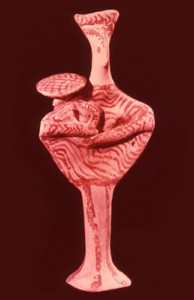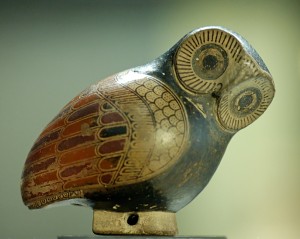Behind the Olive Branch
The Greeks ascribed the source of the olive to Athena, although the tree was first cultivated outside of Greece. The olive has been cultivated for at least 7,000 years, rather significant when you consider that the tree requires a fair amount of knowledge and care to obtain a usable product. The wild olive, native to the eastern Mediterranean, including Greece, produces a long narrow seed with meager flesh, and the tree must be grafted to produce what we would call a true olive. Pruning keeps the tree from growing too large and scraggly over the ten years or more that it takes to begin yielding a significant amount of fruit. Olives off the branch have to be processed, usually fermented in brine, to become edible. Large quantities of olives are crushed, pressed and filtered to produce oil. Whether done with modern or Stone Age methods, it’s a multi-step process that requires time, patience, equipment and collective effort.Athena is an agricultural goddess who invented the plow along with other technology necessary for a settled farming community, such as oxen yokes, pottery, spinning wheels and looms. Her animals are the owl and the snake, both of whom control rodent populations, the scourge of all grain based economies. To create the plow Athena had to invent metallurgy, and she became the patron goddess of metal workers. Eventually metals became used not only to fashion farm and household implements, religious objects, and jewelry, but to create swords, breastplates, and helmets. Athena at this point became a goddess of war. A later myth says she was birthed fully armed from the god Zeus’ head, but Athena is actually a pre-Indo-European goddess and her rein in Greece pre-dates that of Zeus.Even after her warrior goddess reputation was established, Athena remained a goddess of mediation and upholder of law, with a marked reluctance for armed conflict. Agrarian communities need peace in order to thrive. An early temple of Athena on the Acropolis honored the place where she was believed to have planted the first olive tree. The remains of a later temple, the Erechtheum, still stand. This temple was named for Athena’s foster son Erechtheus, who was a snake child born of earth goddess Gaia. The god Poseidon tried to claim the temple site for himself by striking his trident against a rock, spewing forth a salt water spring. Athena would have battled Poseidon for possession, if Zeus had not intervened, imploring the two to accept the judgment of a special council. As instigator of the panel, Zeus had to recuse himself, and the verdict was divided along sexual lines, with all the goddesses favoring Athena and all the gods voting for Poseidon. With one vote to spare, Athena won. Both her tree and Poseidon’s spring were incorporated into the temple complex. Athena and Poseidon’s conflict mirrors the rivalry along the coast between land and sea, where the sea tries to reclaim the land at every turn through storms, tsunamis and the erosion of relentless tides. The appearance of a salty spring on the high rocky outcrop of the Acropolis was a particularly bold invasion. Still, the Greeks must have seen a complementarity between the two deities, because they believed the olive tree could not grow far from the sea. This widespread belief has been verified somewhat; the olive tree thrives in dry, slightly alkaline, calciferous soils common to Mediterranean coastal areas, though it can also be grown in inland areas with similar temperature and soil compositions.Olive oil not only revolutionized dietary and cooking practices in the eastern Mediterranean, it produced a cleaner fuel for lighting and a more stable base for cosmetics. The olive branch became a symbol of prosperity and accomplishment for the Greeks and a symbol of peace for the Romans. Athena was worshipped not just in Athens but along the Italian, Greek and Anatolian coasts as the the goddess of technology, best illustrated by her gift of the olive tree and the knowledge of how to grow and utilize it. SourcesGrimbutas, Marija. The Living Goddesses. Berkeley, CA: University of California Press, 1999.Graves, Robert. The Greek Myths. London: Penguin, 1960.Quennell, Marjorie and C.H.B. Everyday Things in Ancient Greece. London: B.T. Batsford, 1954.





